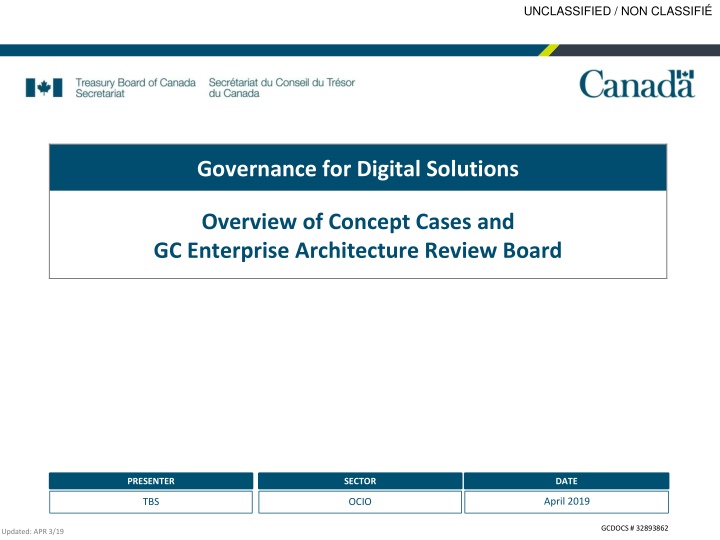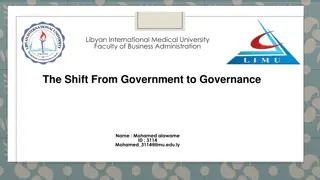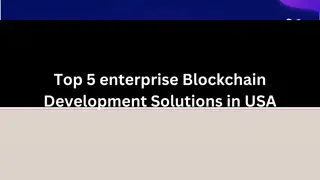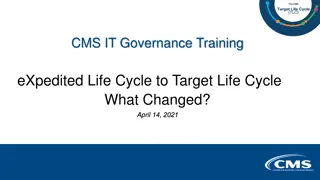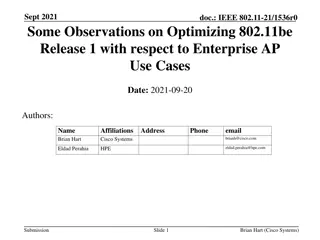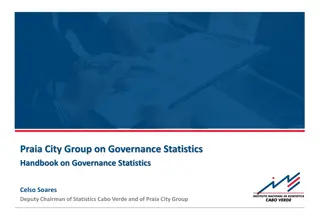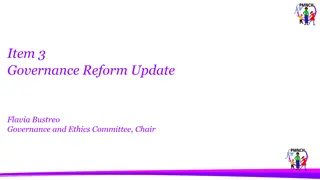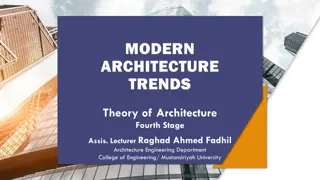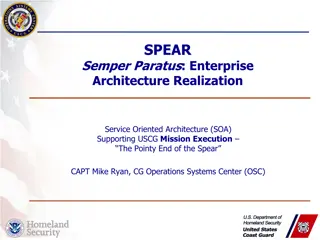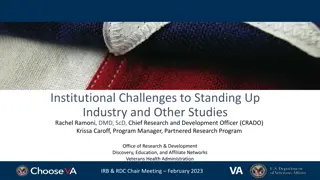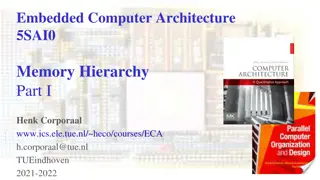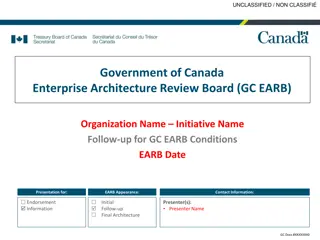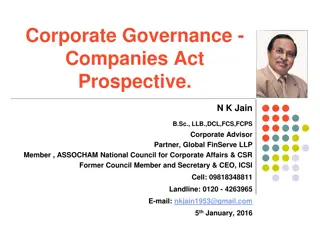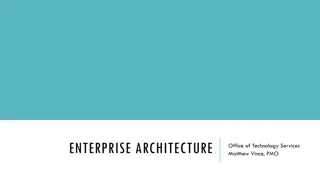Governance for Digital Solutions and Enterprise Architecture Review
This document discusses the importance of enterprise architecture (EA) in achieving organizational objectives, emphasizing the need for strategic planning and alignment with digital standards. It covers the Concept Cases process, the role of the GC Enterprise Architecture Review Board (GC EARB), and the significance of early engagement, solution alignment, and project authority assurance in digital solutions governance. The aim is to guide organizations in leveraging EA for successful project execution and strategic alignment with desired business outcomes.
Download Presentation

Please find below an Image/Link to download the presentation.
The content on the website is provided AS IS for your information and personal use only. It may not be sold, licensed, or shared on other websites without obtaining consent from the author.If you encounter any issues during the download, it is possible that the publisher has removed the file from their server.
You are allowed to download the files provided on this website for personal or commercial use, subject to the condition that they are used lawfully. All files are the property of their respective owners.
The content on the website is provided AS IS for your information and personal use only. It may not be sold, licensed, or shared on other websites without obtaining consent from the author.
E N D
Presentation Transcript
UNCLASSIFIED / NON CLASSIFI Governance for Digital Solutions Overview of Concept Cases and GC Enterprise Architecture Review Board PRESENTER SECTOR DATE April 2019 TBS OCIO GCDOCS # 32893862 Updated: APR 3/19
UNCLASSIFIED / NON CLASSIFI Purpose of Today s Session Highlight the integrated nature of the Digital Project journey Explain the Concept Case process Explain when and why to come to GC EARB 2
UNCLASSIFIED / NON CLASSIFI What is Enterprise Architecture (EA) ? An enterprise architecture (EA) is a conceptual blueprintthat defines the structure and operation of an organization. The intent of an enterprise architecture is to determine how an organization can most effectively achieve its current and future objectives. https://searchcio.techtarget.com/definition/enterprise-architecture Enterprise architecture (EA) is a discipline for proactively and holistically leading enterprise responses to disruptive forces by identifying and analyzing the execution of change toward desired business vision and outcomes. https://www.techopedia.com/definition/24746/enterprise-architecture-ea a discipline for proactively and holistically leading enterprise responses to disruptive forces by identifying and analyzing the execution of change toward desired business vision and outcomes. EA delivers value by presenting business and IT leaders with signature-ready recommendations for adjusting policies and projects to achieve target business outcomes that capitalize on relevant business disruptions. https://www.gartner.com/it-glossary/enterprise-architecture-ea/ 3
UNCLASSIFIED / NON CLASSIFI Why Do We Do EA? Where do we need to be NOW so that we are in the right place then? What will the world be like in 2025? What are other government jurisdictions doing How do we compare? A process to determine where an organization is going over a defined period of time and specify how it intends to get there Strategic planning is an evolutionary process that should be part of a continuous management lifecycle. The real benefit and value of strategic planning process is the process 1 4 1 PM Boulevard Article, The Strategy Lifecycle by James Picard, Robbins-Giola, LLC. September 2006
UNCLASSIFIED / NON CLASSIFI Governance for Digital Solutions EARLY ENGAGEMENT SOLUTION ALIGNMENT PROJECT AUTHORITY ASSURANCE Project Execution Budget Proposal & M.C. Solution Architecture TB Sub (TB) Concept Case Identifies and defines strategic needs by the business GC EARB TB Project Oversight Submission Mandatory Procedure Directive OPMCA Requirements Ongoing Project Monitoring Has the problem or opportunity been well defined? Have the GC Digital Standards and Architecture Standards been applied? Does the project comply to TB policies? Is the project positioned for success? Is it aligned with GC Strategies? Are course corrections needed? Is there a clear vision of the desired business outcomes and future state? Is the initiative a candidate to drive out new GC reference architectures? Has the project been to GC EARB? Is there alignment to using GC Digital Standards? 5
UNCLASSIFIED / NON CLASSIFI Why Concept Cases? Let s work the problem, people. Let s not make things worse by guessing. Gene Kranz, Flight Director Apollo 13 Explore and Refine the Business Problem Ensure a clear understanding of the business problem before discussing solutions. Early engagement with TBS to ensure alignment prior to proceeding with the investment planning process. Ensure that investments are conceived in a manner that aligns with the Government of Canada s Digital Standards. Don t Jump Directly to Solutions 6
UNCLASSIFIED / NON CLASSIFI What is a Concept Case? Concept Case Date: Proposed Initiative: Department: ADM Business Owner: Problem/Opportunity Desired Business Outcome Explain the business problem/opportunity that needs to be solved in one sentence. What are your desired business outcomes? Future State Current State/Context P Explain the current state in which the problem/opportunity exists. Provide evidence to support the business problem/opportunity. Describe the future state in terms of business capabilities required. Next Steps Root Cause What are the next steps? Are there any known time constraints moving forward? Why does the problem or opportunity exist? 7
UNCLASSIFIED / NON CLASSIFI Problem Solving is an Investment Value of the Problem (KPIs, Metrics) Customer Perspective Root Cause Environmental Analysis (PESTLE) Constraints Problem Analysis History of the Problem Business Owner It s not that I m so smart, it s just that I stay with problems longer. Albert Einstein 8
UNCLASSIFIED / NON CLASSIFI Concept Case Process Identify Develop Respond Review Use criteria (below) to determine which potential investments require concept case Work directly with TBS OCIO for advice on the development of concept cases GC CIO endorses concept case OCIO subject matter experts (e.g. cyber, cloud) analyse concept cases and provide feedback Response provided to department with endorsement and guidance Engage with TBS Program Sector analyst and the Office of the Chief Information Officer (OCIO) Submit concept case to TBS Program Sector analyst Criteria* The initiative is at the concept stage prior to either a memorandum to cabinet, a business case, or a Treasury Board submission. It is likely that the initiative will use digital technology. The department is willing to spend more than the following to solve the business problem: Small Departments and Agencies = $2.5M Medium to Large Departments = $5.0M Department of National Defence = $15 M Links for Mandatory Procedures on Concept Cases and the Concept Case Template English https://www.tbs-sct.gc.ca/pol/doc-eng.aspx?id=32578 French https://www.tbs-sct.gc.ca/pol/doc-fra.aspx?id=32578 *Mandatory Procedure on Concept Cases (Policy on Investment Planning Assets and Acquired Services) 9
UNCLASSIFIED / NON CLASSIFI What is the GC EARB? In order to optimize the business, the Digital Strategy will position the user first in an open, collaborative and accessible way using digital solutions to deliver services. Digitally, the GC must operate as one to benefit all Canadians. Mandate: The Policy on the Management of Information Technology assigns responsibility to the Chief Information Officer of Canada to establish an implement an Enterprise Architecture Review Board that is mandated to define current and target architecture standards for the Government of Canada, and review departmental plans to ensure alignment. Provide technical recommendations and highlight enterprise-wide directions to the GC CIO for consideration and approval. TB Policy on the Management of IT (April 1, 2018)https://www.tbs-sct.gc.ca/pol/doc-eng.aspx?id=12755#appA 10
UNCLASSIFIED / NON CLASSIFI When to come to GC EARB? The Criteria Engaging EARB Proposals concerned with the design, development, installation and implementation of digital services or solutions, information systems and applications ( digital initiatives ) where the department is willing to invest a minimum of the following amounts in order to address the problem or take advantage of the opportunity: $10 million $15 million $2.5 million + OPMCA of 0 or 1 $5 million + OPMCA of 2 + OPMCA of 3 Department of National Defence $25 million + OPMCA of 4 That involve emerging technologies; That require an exception to any applicable Directive or Standard under the Policy on the Management of Information Technology; That are categorized at the protected B level or below using a deployment model other than public cloud for application hosting (including infrastructure), application deployment, or application development; or As directed by the Chief Information Officer of Canada. NOTE: Please ensure that all proposals submitted for review by the Government of Canada Enterprise Architecture Review Board have first been assessed by the departmental architecture review board where one has been established. Ensure that proposals are submitted to the Government of Canada Enterprise Architecture Review Board following review of concept cases1 for digital projects and before the development of a Treasury Board Submission or Departmental Business Case. Ensure all departmental initiatives are assessed against and meet the requirements of Appendix C: Mandatory Procedures for Enterprise Architecture Assessment and Appendix D: Mandatory Procedures for Application Programming Interfaces. https://www.tbs-sct.gc.ca/pol/doc-eng.aspx?id=15249 11
UNCLASSIFIED / NON CLASSIFI Engagement Criteria What Has Changed 1 Clearly Defined Criteria Directive on the Management of Information Technology Mandatory Procedures for Enterprise Architecture 2 Directive on the Management of Information Technology Appendix C 3 Mandatory Procedures for Application Programming Interfaces Directive on the Management of Information Technology Appendix D 12
UNCLASSIFIED / NON CLASSIFI What Do I Do First? 1 2 3 Conduct a self- assessment of your initiative against the Criteria to determine if you should be presenting to the GC EARB. Ensure that all proposals submitted for review to GC EARB have first been assessed by your DARB (Departmental Architecture Review Board) where one has been established. Ensure your departmental initiatives are assessed against and align to the requirements set out as the GC Architectural Standards. IF so, complete the GC EARB Template Directive on the Management of Information Technology : POLICY: Criteria https://www.tbs-sct.gc.ca/pol/doc-eng.aspx?id=15249 Image result for vision Results Enabler Digial Stds. Arch. Stds. EARB Template: https://wiki.gccollab.ca/GC_EARB IT Supplier 13
UNCLASSIFIED / NON CLASSIFI How do you go about getting on the agenda? 1GC Pedia https://wiki.gccollab.ca/GC_EARB Departmental Input Go to GC Pedia to attain the most recent GC EARB Presenter Template Complete the deck Email the deck to the generic mailbox: ZZCIOBDP@tbs-sct.gc.ca TBS OCIO (EA Review) GC EARB team receives alert of a new submission. A tentative date for the presentation is identified. A GC EA team conducts a review the input material. Comments are provided back to the department for clarification. A call/meeting occurs to discuss feedback and refine understanding. Updated presentation materials may be requested. The EARB meeting date is confirmed. Prepare Assessment An architectural assessment is prepared by the GC EA team. Alignment against both the GC Digital and GC Architectural Standards is performed. This feedback is provided to the department as well as used to brief the Co-chairs of the GC EARB prior to the meeting. 13
UNCLASSIFIED / NON CLASSIFI How it works what to expect 2 Getting ready for the meeting TBS-OCIO Secretariat 2 weeks ahead: The Secretariat will extend the calendar invitations to the presenters (typically 1-2 people) 1 week ahead: They will request the presentation materials (both French and English) 1 week prior to the session They prepare information packages for the EARB membership to review ahead of the meeting. GC EARB Meeting Time to present (being clear to the Board why you are here . To seek endorsement to xxx ) A Record of Discussion (RoD) is prepared after the meeting to capture any highlights that the Board noted, as well as the decision of the Board with any conditions. NOTE: The RoD may take several weeks to be officially published, but will be available on the GC EARB GC Pedia site. Follow Up There are times when departments must return to the GC EARB as a result of where the project is in it cycle, or from conditions identified by the Board. The GC EA team will capture the need for a future visit and proactively schedule it on the GC EARB Forward Agenda. 14
UNCLASSIFIED / NON CLASSIFI Where to get more information Today https://wiki.gccollab.ca/GC_EARB GC Wiki GC Wiki GC Connex GC Collaboration ZZCIOBDP@tbs-sct.gc.ca 16
UNCLASSIFIED / NON CLASSIFI APPENDIX: 1 1 - - GC Digital Standards 2 2 - - GC Architectural Standards 3 3 - - High Level Process View 4 4 - - GC EARB Assessment 18
UNCLASSIFIED / NON CLASSIFI APPENDIX 1 1 GC Digital Standards Build in accessibility from the start Design with users Empower staff to deliver better services Iterate and improve frequently Work in the open by default Be good data stewards Use open standards and solutions Design ethical services Address security and privacy risks Collaborate widely 19
UNCLASSIFIED / NON CLASSIFI APPENDIX 2 2Mandatory Procedures for Enterprise Architecture Assessment GC Architectural Standards Align to the GC Business Capability model Design for Users First and Deliver with Multidisciplinary Teams Design Systems to be Measurable and Accountable Business Architecture Data Collection Data Management Data Storage Data Sharing Information Architecture Maximize Reuse Enable Interoperability Use open standards and Solutions by Default Application Architecture Use Cloud first Design for Performance, Availability, and Scalability Technology Architecture Security & Privacy Design for Security and Privacy 20
UNCLASSIFIED / NON CLASSIFI Business Architecture Align to the GC Business Capability model Define program services as business capabilities to establish a common vocabulary between business, development, and operation Identify capabilities that are common to the GC enterprise and can be shared and reused Model business processes using Business Process Modelling Notation (BPMN) to identify common enterprise processes Design for Users First and Deliver with Multidisciplinary Teams Focus on the needs of users, using agile, iterative, and user-centred methods Conform to both accessibility and official languages requirements Include all skillsets required for delivery, including for requirements, design, development, and operations Work across the entire application lifecycle, from development and testing to deployment and operations Ensure quality is considered throughout the Software Development Lifecycle Ensure accountability for privacy is clear Encourage and adopt Test Driven Development (TDD) to improve the trust between Business and IT Design Systems to be Measurable and Accountable Publish performance expectations for each IT service Make an audit trail available for all transactions to ensure accountability and non-repudiation Establish business and IT metrics to enable business outcomes Apply oversight and lifecycle management to digital investments through governance 21
UNCLASSIFIED / NON CLASSIFI Information Architecture Data Collection Ensure data is collected in a manner that maximizes use and availability of data Ensure data collected aligns to existing enterprise and international standards Where enterprise or international standards don t exist, develop Standards in the open with key subject matter experts Ensure collection of data yields high quality data as per data quality guidelines Ensure data is collected through ethical practices supporting appropriate citizen and business-centric use Data should only be purchased once and should align with international standards Where necessary, ensure collaboration with department/ agency data stewards/ custodians, other levels of government, and Indigenous people Data Management Demonstrate alignment with enterprise and departmental data governance and strategies Ensure accountability for data roles and responsibilities Design to maximize data use and availability Data Storage Ensure data is stored in a secure manner in accordance with the National Cyber Security Strategy, and the Privacy Act Follow existing retention and disposition schedules Ensure data is stored in a way to facilitate easy data discoverability, accessibility, and interoperability Data Sharing Data should be shared openly by default as per the Directive on Open Government Ensure government-held data can be combined with data from other sources enabling interoperability and interpretability through for internal and external use Reduce the collection of redundant data Reuse existing data where possible Encourage data sharing and collaboration 22
UNCLASSIFIED / NON CLASSIFI Application Architecture Use Open Standards and Solutions by Default Where possible, use open standards and open source software first. If an open source option is not available or does not meet user needs, favour platform-agnostic COTS over proprietary COTS, avoiding technology dependency, allowing for substitutability and interoperability If a custom-built application is the appropriate option, by default any source code written by the government must be released in an open format via Government of Canada websites and services designated by the Treasury Board of Canada Secretariat All source code open must be released under an appropriate open source software license Expose public data to implement Open Data and Open Information initiatives Maximize Reuse Leverage and reuse existing solutions, components, and processes Select enterprise and cluster solutions over department-specific solutions Achieve simplification by minimizing duplication of components and adhering to relevant standards Inform the GC EARB about departmental investments and innovations Share code publicly when appropriate, and when not, share within the Government of Canada Enable Interoperability Expose all functionality as services Use micro services built around business capabilities. Scope each service to a single purpose Run each IT service in its own process and have it communicate with other IT services through a well-defined interface, such as an HTTPS-based application programming interface (API) as per Appendix D: Mandatory Procedures for Application Programming Interfaces of the Directive on Information Technology1 Run applications in containers Leverage the GC Digital Exchange Platform for components such as the API Store, Messaging, and the GC Service Bus _______________________________________________________________________________________________ 1 Directive on the Management of Information Technology : https://www.tbs-sct.gc.ca/pol/doc-eng.aspx?id=15249 23
UNCLASSIFIED / NON CLASSIFI Technology Architecture Use Cloud first Enforce this order of preference: Software as a Service (SaaS) first, then Platform as a Service (PaaS), and lastly Infrastructure as a Service (IaaS) Enforce this order of preference: Public cloud first, then Hybrid cloud, then Private cloud, and lastly non-cloud (on-premises) solutions Design for cloud mobility and develop an exit strategy to avoid vendor lock-in Design for Performance, Availability, and Scalability Design for resiliency Ensure response times meet user needs for availability Support zero-downtime deployments for planned and unplanned maintenance Use distributed architectures, assume failure will happen, handle errors gracefully, and monitor actively 24
UNCLASSIFIED / NON CLASSIFI Security Architecture and Privacy Design for Security and Privacy Implement security across all architectural layers Categorize data properly to determine appropriate safeguards Perform a privacy impact assessment (PIA) and mitigate all privacy risks when personal information is involved Balance user and business needs with proportionate security measures and adequate privacy protections. 25
UNCLASSIFIED / NON CLASSIFI APPENDIX 3 High Level Process View 1 2 3 4 5 Prepare Concept Case Add project to Departmental IBP and IT PLAN Prepare for GC EARB TB Submission .or. Dept. project GC EARB Detailed Architecture Identified business investment Submit to OCIO for review Prepare Presenter Template Project execution (Gating model) EARB Assessment (align to Stds.) Identified digital project Concept Case defined strategic needs Department ARB Meeting GC EARB Meeting On-going Project Governance & Oversight * CLOUD Process : AllCloud Services must be requested through SSC s Serving Government website. 23
UNCLASSIFIED / NON CLASSIFI From Concept to Execution Setting the foundation for collaborative IT-enabled results delivery OCIO provides input on digital standards & suggests paths for alignment Confirm alignment to digital standards against conceptual architecture Provide direction as needed Concept Case Identifies and defines strategic needs by the business Measure outcomes Benefit Realization EARB Engagement Architecture Analysis (DRF /KPI) Continuous Improvement TB Submission Project Execution Align Business Capabilities to IT solution Digitalization & automation of business processes that provide measurable outcomes Fulsome business case Early indications for digital solution needs Add/Update new solution(s) in Departmental APM (Application Portfolio Mgt.) EARB Engagement Align IT with GC Digital and Architectural Standards Departmental Planning Project Gating Identified in: Departmental Integrated Business Plan IT Plan During the planning phase of the project - solution architectures presented to the GC EARB Gate 2/3: Establish solution architecture Seek Departmental ARB endorsement, Validate that previous recommendations have been addressed Monitor selected digital projects 27
UNCLASSIFIED / NON CLASSIFI APPENDIX 4 4 GC EARB Assessment - 3 pages 28
UNCLASSIFIED / NON CLASSIFI Dept. Title Enterprise Architecture Fitness Assessment Summary Overall: Endorsement Information Costs : One time:$ On going: $ Proof of Concept Experiment Pilot Implementation GATE: ____ Project Intent Public Facing Enterprise Enterprise Cluster Transformational Other EARB Review Category SaaS PaaS IaaS Not Applicable Type of Cloud Unclassified Protected A Protected B Other Data Classification SSC PSPC Departmental Unknown Procurement Vehicle Within Departmental Authority Outside Departmental Authority Financial Authority Describe the Investment Proposal GC EARB Recommendation GC EARB Endorsement Conditions Comments EARB Appearance: Initial Follow-up Architectural Alignment: 29 Fully Partially Not
UNCLASSIFIED / NON CLASSIFI Mandatory Procedures for Enterprise Architecture Assessment GC Architectural Standards _ Align to the GC Business Capability model _ Design for Users First and Deliver with Multidisciplinary Teams _ Design Systems to be Measurable and Accountable Business Architecture _ Data Collection _ Data Management _ Data Storage _ Data Sharing Information Architecture _ _ Maximize Reuse _ Enable Interoperability Use open standards and Solutions by Default Application Architecture _ Use Cloud first _ Design for Performance, Availability, and Scalability Technology Architecture Security & Privacy _ Design for Security and Privacy Architectural Alignment: 30 Fully Partially Not
UNCLASSIFIED / NON CLASSIFI Digital Alignment Design with users Research with users to understand their needs and the problems we want to solve. Conduct ongoing testing with users to guide design and development. Build in accessibility from the start Services should meet or exceed accessibility standards. Users with distinct needs should be engaged from the outset to ensure what is delivered will work for everyone. Iterate and improve frequently Develop services using agile, iterative and user-centred methods. Continuously improve in response to user needs. Try new things, start small and scale up. Empower staff to deliver better services Make sure that staff have access to the tools, training and technologies they need. Empower the team to make decisions throughout the design, build and operation of the service. Work in the open by default Share evidence, research and decision making openly. Make all non-sensitive data, information, and new code developed in delivery of services open to the outside world for sharing and reuse under an open license. Be good data stewards Collect data from users only once and reuse wherever possible. Ensure that data is collected and held in a secure way so that it can easily be reused by others to provide services. Use open standards and solutions Leverage open standards and embrace leading practices, including the use of open source software where appropriate. Design for services and platforms that are seamless for Canadians to use no matter what device or channel they are using. Design ethical services Make sure that everyone receives fair treatment. Comply with ethical guidelines in the design and use of systems which automate decision making (such as the use of artificial intelligence). Address security and privacy risks Take a balanced approach to managing risk by implementing appropriate privacy and security measures. Make security measures frictionless so that they do not place a burden on users. Collaborate widely Create multidisciplinary teams with the range of skills needed to deliver a common goal. Share and collaborate in the open. Identify and create partnerships which help deliver value to users. Architectural Alignment: Fully Partially Not
